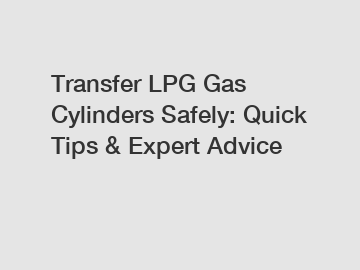Transfer LPG Gas Cylinders Safely: Quick Tips & Expert Advice
As responsible homeowners, ensuring the safe transfer and handling of LPG gas cylinders should be our top priority. Whether you are planning to move residences or simply need to relocate your gas cylinder within your home, it is crucial to follow specific guidelines to prevent potential accidents or mishaps. In this blog, we provide you with quick tips and expert advice on how to transfer LPG gas cylinders safely, based on years of experience and reliable sources.
1. Understand the Risks Involved.
Before attempting to transfer or relocate LPG gas cylinders, it's essential to comprehend the potential dangers associated with mishandling them. Liquefied Petroleum Gas (LPG) is a highly flammable substance and improper handling can lead to gas leaks, fires, or explosions. Being aware of these risks will ensure you approach the task with the necessary caution and diligence.

2. Prepare Adequate Safety Equipment.
To safely transfer LPG gas cylinders, you must have the appropriate safety equipment on hand. Some essential items include safety gloves, safety glasses, a fire extinguisher, leak detection solution, and a ventilation fan. These tools will protect you from potential accidents and help you identify leaks, if any.
3. Ensure Proper Ventilation.
When it comes to transferring LPG gas cylinders, always ensure you have adequate ventilation in the area. Open windows and doors to allow fresh air to circulate, preventing any build-up of gas. Ventilation is crucial as LPG gas is denser than air and can settle in low-lying or confined spaces, increasing the risk of ignition.
4. Check for Leaks.
One of the most critical aspects of the gas cylinder transfer process is to check for potential leaks. Before initiating any movement, apply a leak detection solution around the valve and connections. If bubbles appear, immediately turn off the cylinder and contact your gas supplier for further assistance. Never attempt to transfer a leaking cylinder.
5. Secure Gas Cylinder for Transportation.
When transferring an LPG gas cylinder from one location to another, make sure it is properly secured. This minimizes the risk of the cylinder shifting or falling during transportation, which could lead to damage or gas leaks. Use a purpose-built trolley for easy and safe movement, ensuring it is securely fastened to avoid any accidents.
6. Avoid Direct Sunlight and Heat.
During transportation or temporary storage, always keep LPG gas cylinders away from direct sunlight and any sources of heat. Prolonged exposure to high temperatures can lead to increased pressure within the cylinder, potentially causing a rupture or explosion. Store cylinders in well-ventilated, shaded areas to ensure their safety.
7. Acquaint Yourself with Emergency Procedures.
Despite all precautions, emergencies can still occur. It is crucial to familiarize yourself with emergency procedures and have a clear plan in case of a gas leak or fire. Know how to shut off the gas supply and be aware of the nearest exit points. Additionally, ensure everyone in your household is aware of these procedures and understands their role in case of an emergency.
8. Seek Professional Help if Required.
If you are unsure about transferring LPG gas cylinders or have concerns about safety, it is always best to seek professional assistance. Gas suppliers or technicians possess the necessary expertise and knowledge to handle and transfer gas cylinders correctly. Their guidance can provide peace of mind while ensuring everything is handled safely and efficiently.
Conclusion.
Your safety and the safety of those around you should always be a top priority when transferring LPG gas cylinders. Following these quick tips and expert advice will help you ensure the safe transfer of gas cylinders, minimizing the risk of accidents, leaks, or fires. Remember to acquaint yourself with local regulations, as they may provide additional guidelines specific to your area. By adhering to proper procedures and taking necessary precautions, you can confidently and safely transfer LPG gas cylinders with ease.
For more lpg cylinder 26.5l for sale, seamless steel gas cylinders supplier, cng cylinder sizesinformation, please contact us. We will provide professional answers.

Comments